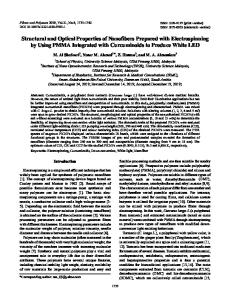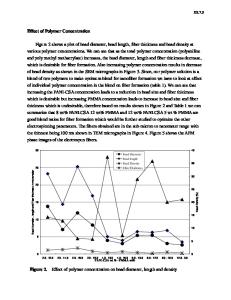Carbon nanofibers prepared by electrospinning accompanied with phase-separation method for supercapacitors: Effect of th
- PDF / 652,272 Bytes
- 11 Pages / 584.957 x 782.986 pts Page_size
- 101 Downloads / 457 Views
shan Linb) School of Material Science and Engineering, Lanzhou University of Technology, Lanzhou 730050, Gansu, People’s Republic of China
Chang Liu School of Material Science and Engineering, Lanzhou University of Technology, Lanzhou 730050, Gansu, People’s Republic of China; and Department of Chemistry, University of New Hampshire, Durham, New Hampshire 03824, USA
Wenchun Wang School of Material Science and Engineering, Lanzhou University of Technology, Lanzhou 730050, Gansu, People’s Republic of China
Long Kang and Fen Rana) State Key Laboratory of Advanced Processing and Recycling of Non-ferrous Metals, Lanzhou University of Technology, Lanzhou 730050, People’s Republic of China; and School of Material Science and Engineering, Lanzhou University of Technology, Lanzhou 730050, Gansu, People’s Republic of China (Received 28 July 2017; accepted 23 August 2017)
Carbon nanofibers are prepared via the electrospinning method accompanied by the phaseseparation process using polyacrylonitrile as a carbon precursor. Effects of preoxidation and carbonation temperatures on electrochemical performance are studied and optimized in detail. The morphology and porous structure are characterized by scanning electron microscope, transmission electron microscope, and nitrogen adsorption and desorption measurements, respectively; the electrochemical performances are measured by the CHI660E workstation. The results show that the diameter of carbon nanofibers is about 150–200 nm with a uniform and smooth surface. The optimized preoxidation temperature is 280 °C with a carbonation temperature of 700 °C. The highest capacitance is up to 155 F/g, and the symmetric supercapacitor delivers a maximum energy density of 7.78 W h/kg with a power density of 400 W/kg and a maximum power density of 4000 W/kg with an energy density of 2.0 W h/kg. The symmetric supercapacitor also exhibits good cycle stability 91.0% of initial specific capacitance after 5000 cycles.
I. INTRODUCTION
The consumption of non-renewable energy resources especially fossil fuels has a great effect on the climate change and world economy. Moreover, with a fastgrowing market for portable electronic devices and the development of hybrid electric vehicles, there has been an ever increasing and urgent demand for environmentally friendly high-power energy resources.1–3 In recent years, Li ion batteries and supercapacitor energy devices
Contributing Editor: Tianyu Liu a) Address all correspondence to this author. e-mail: [email protected] or [email protected] b) These authors contributed equally to this work. DOI: 10.1557/jmr.2017.373
have been investigated and applied widely in many kinds of energy storage devices containing a lead-acid battery, Ni-MH battery, Na ion battery, etc. To our knowledge, electrochemical capacitors (ECs), also called supercapacitors or ultracapacitors, have been paid more attention as a high power device owing to its fast charging/discharging ability in seconds, high power density, and long cycle life. What is more, ECs bridge the gap between traditional
Data Loading...











